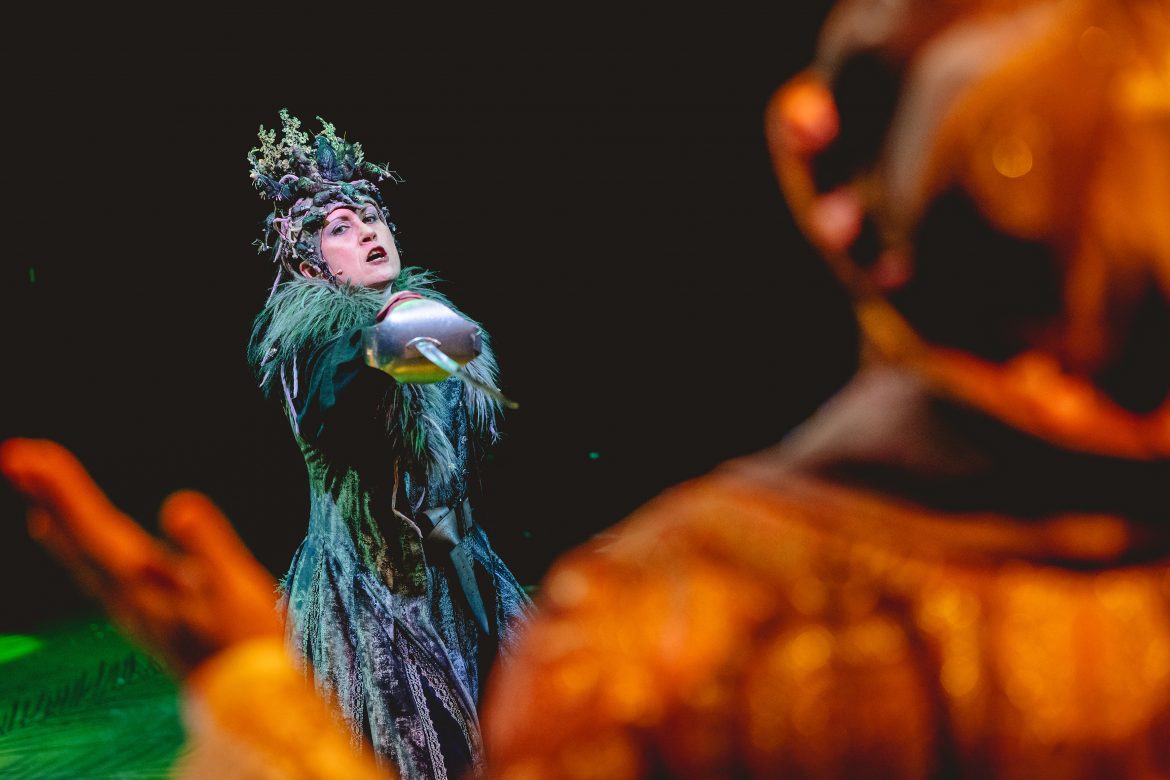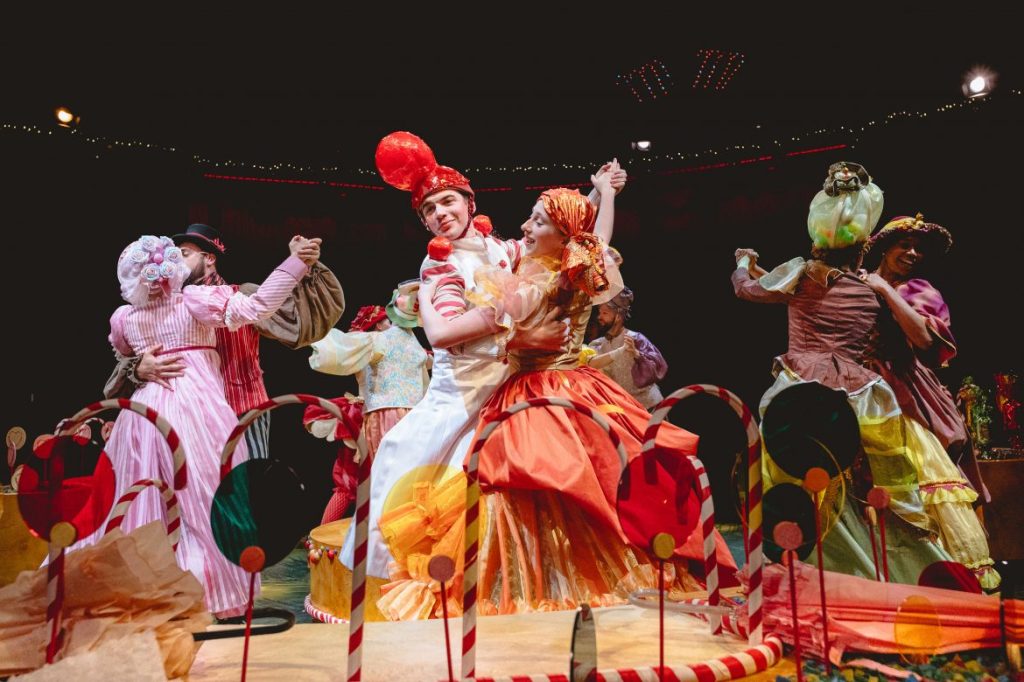It was an unusual decision for the New Vic’s Christmas production to emulate a ballet story close to the original ballet. But a couple of audacious decisions makes The Nutcracker one of their most successful Christmas productions.
One sign that the New Vic does something right with its Christmas production: there’s so much demand it runs to the end of January. That’s also convenient for me because it’s something on my calendar in an otherwise empty month. Catching The Nutcracker at the end of its run, I was hearing a lot of praise, but there was a difference with Theresa Heskins’s latest winter play. Usually there’s a substantially different angle on the source material clear from the outset. This time, it’s not so obvious. There’s still ballet – in fact, in order to have an ensemble who can do the a ballet needed it’s almost entirely a new cast. The original music by Tchaikovsky has been kept. Is this not just a repeat of the famous ballet piece?
Not really. This piece can perhaps be described as how The Nutcracker would have been written as a theatre piece with ballet in, as opposed to a pure ballet production. Most ballet productions have plenty of set pieces dances, with the greatest ones having legendary music. But as far as the storyline is concerned … it doesn’t half go on a bit. We all love the tunes of the Arabian Dance, Russian Dance, Chinese Dance, Dance of the Reed Flutes and Waltz of the Flowers, but it’s a guaranteed fail of the “get on with it test”. And some bits of the story in act one are just … weird. Including, for some reason, a battle between gingerbread men and the terrible evil mouse queen. Theresa Heskins respond to these two challenges with two audacious decisions – and they pay off.
 Firstly, the weird mouse battle. The easy and safe solution is to just cut it. Heskins not only keeps it, but ups its prominence in the story. You might think that nobody’s going to buy into a story where the villain is a mouse, but we’re in land where everything in made of confectionery. Remember, those little buggers eat everything. The first mention of the mouse queen is in the real-world opening scene, where Uncle Drosselmeyer tells the tall tale of the mouse queen’s threat to the sugar plum fairy. The setting is now an unsettled family forced to relocate by war (a nod to Ukraine families currently in Stoke), and Marie has an older sister who died, but other than that, the Act I story is reasonably faithful to the Act I of the ballet.
Firstly, the weird mouse battle. The easy and safe solution is to just cut it. Heskins not only keeps it, but ups its prominence in the story. You might think that nobody’s going to buy into a story where the villain is a mouse, but we’re in land where everything in made of confectionery. Remember, those little buggers eat everything. The first mention of the mouse queen is in the real-world opening scene, where Uncle Drosselmeyer tells the tall tale of the mouse queen’s threat to the sugar plum fairy. The setting is now an unsettled family forced to relocate by war (a nod to Ukraine families currently in Stoke), and Marie has an older sister who died, but other than that, the Act I story is reasonably faithful to the Act I of the ballet.
And now Act II, and the really audacious decision: apart from the Sugar Plum Fairy, all of the famous dances immortalised by the Nutcracker Suite are cut. The music is still there, but it’s shorter and mostly repurposed to low-key incidental music. Instead, it’s about a race to save the Sugar Plum fairy from mousezilla … except it isn’t. Princess Sugar Plum is the new life for lost sister Clara (in the ballet, a common alternate name for Marie). In fact, the whole story after scene 1 is really a story from Uncle Drosselmeyer, a comforting tale of a better place where Clara is now. This is radically different from the story of original Act II. But it’s a plausible Act II that Tchaikovsky might have written – in real life, he lost a sister of his own.
 I don’t normally run down everybody in the creative team – most of the time, it’s a team game and it’s hard to tell who owns credit for what. But I absolutely must give credit to Beverly Norris-Edmunds for her movement direction and choreography. It was not essential to have the ballet in a play (except maybe the Sugar Plum Fairy), but it added a lot. Neither, however, was it a rerun of the classic dance set – instead it’s seamless integrated into the acting. What really impressed me, however, was the level of attention to detail, such as the battle with the Mouse Queen. So much thoughts was given to movement here: the rag doll, for instance, moves very differently to the china doll. A mention to set designer Laura Willstead too. All of the New Vic’s Christmas productions have luscious sets, but this topped must of them with a very clever effect for the Christmas tree growing as Marie shrinks.
I don’t normally run down everybody in the creative team – most of the time, it’s a team game and it’s hard to tell who owns credit for what. But I absolutely must give credit to Beverly Norris-Edmunds for her movement direction and choreography. It was not essential to have the ballet in a play (except maybe the Sugar Plum Fairy), but it added a lot. Neither, however, was it a rerun of the classic dance set – instead it’s seamless integrated into the acting. What really impressed me, however, was the level of attention to detail, such as the battle with the Mouse Queen. So much thoughts was given to movement here: the rag doll, for instance, moves very differently to the china doll. A mention to set designer Laura Willstead too. All of the New Vic’s Christmas productions have luscious sets, but this topped must of them with a very clever effect for the Christmas tree growing as Marie shrinks.
There is just one small irritation, and it’s an unfortunate one. The performance features live musicians and a wonderfully-decorated chamber – but it’s individual parts from the original orchestral score, with the rest of the orchestra done by recorded sound. The problem is, that meant the musicians were left without any real function. Why not just do the whole lot as a recorded soundtrack? I get the impression that the plan for the music evolved over time and this end results wasn’t the original plan – and it would be churlish to say to your musicians “Sorry, don’t need you any more” halfway through rehearsals. But I can think of at least two ways they could have made the musicians a more integral part of the production (something Conrad Nelson did very well in The Card). I would find it demoralising if I felt my role was dispensable, and I always prefer it where every person on stage is contributing something that would be missed without.
But that’s a small issue for an otherwise excellent all-round productions. This could easily have been done as a safe-bet production closely mimicking the ballet and it would still have been an easy success, but it is impressive to have taken a couple of bold gambles to make it more like a theatre piece than a ballet piece and create something new. I saw the very last performance so it’s too late to go back now, but I reckon this one will be back. If it does, take the chance to see it then.
